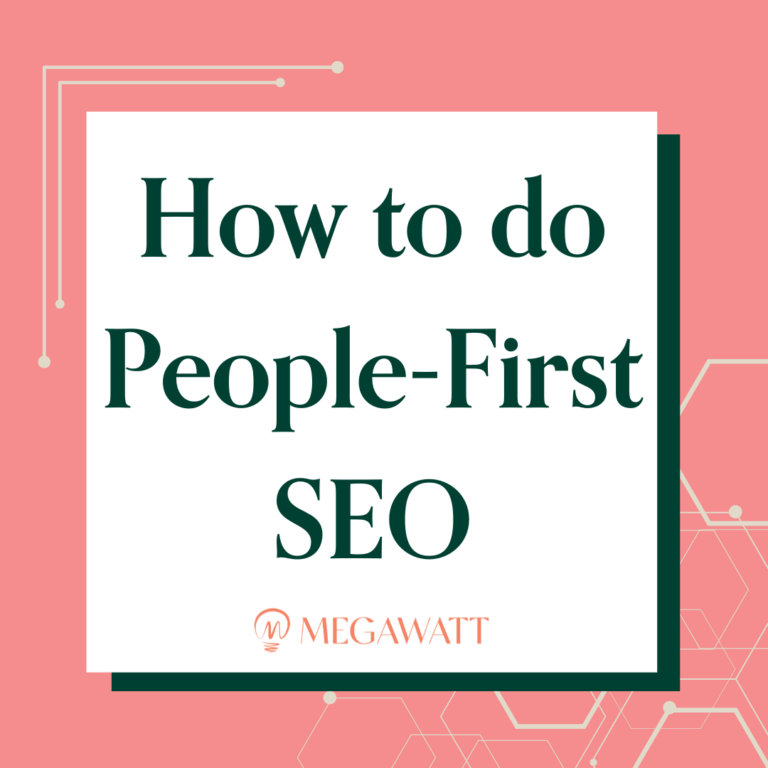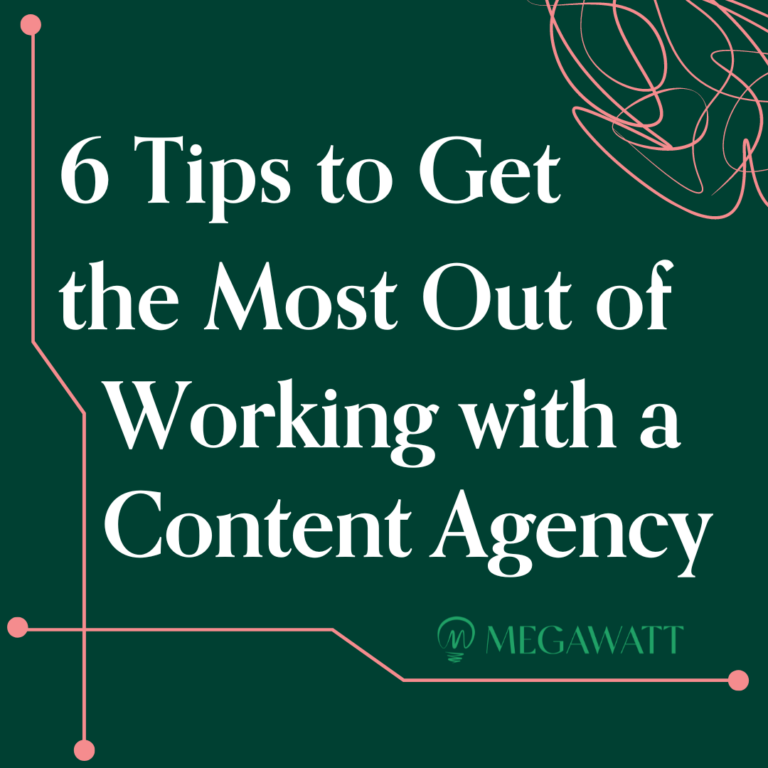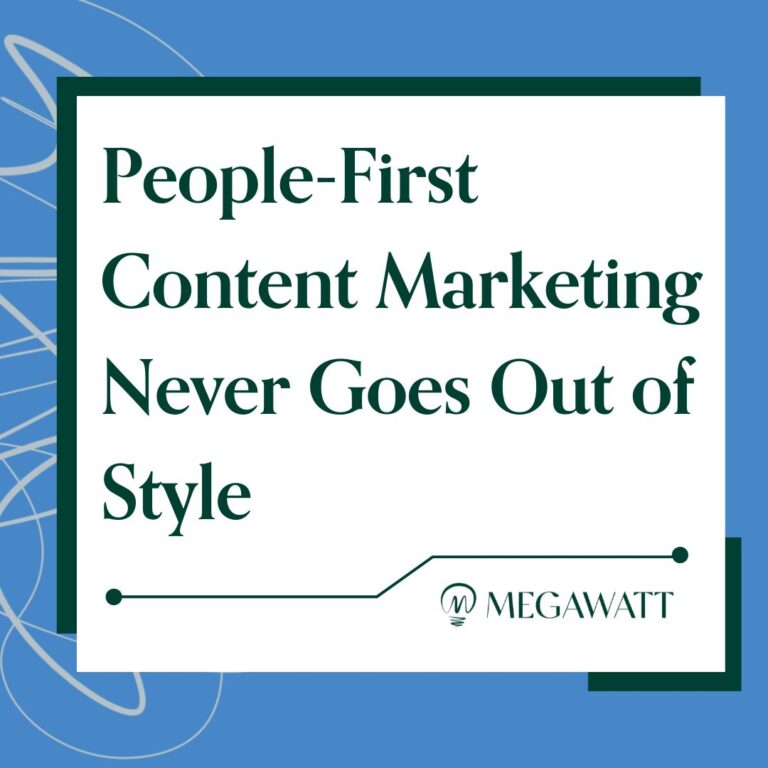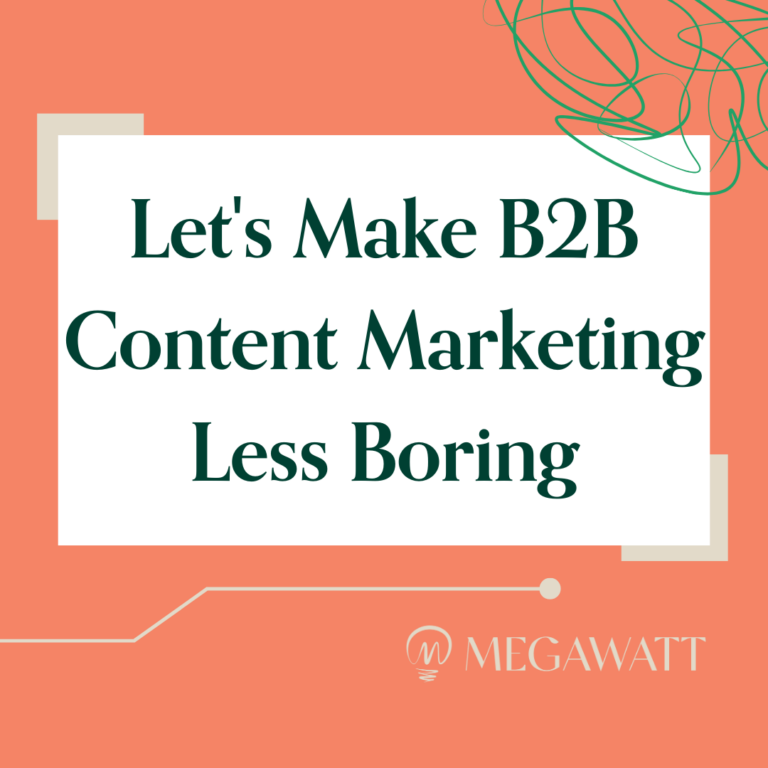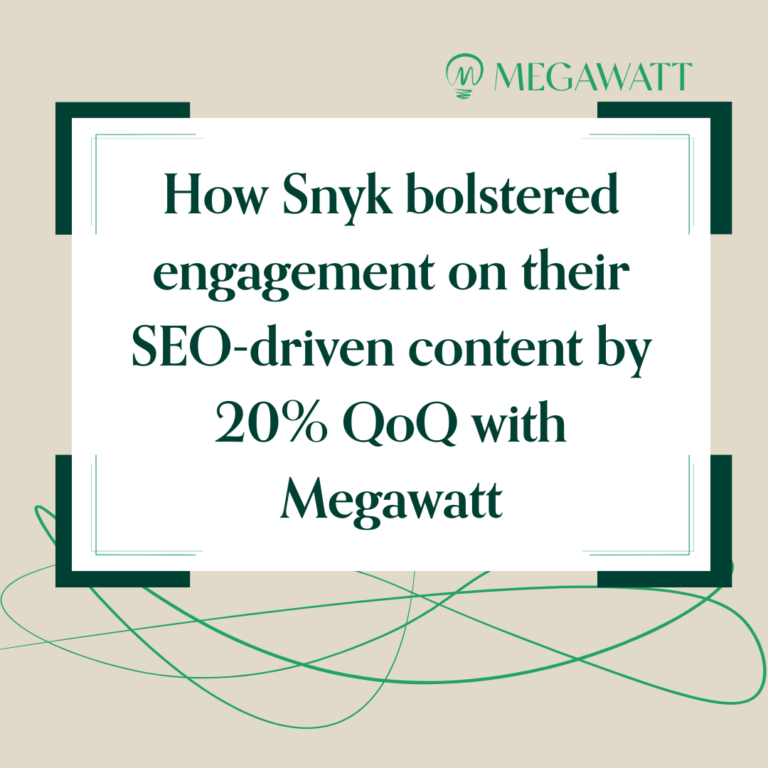Multitasking can be beneficial in some aspects of work and life — if you can squeeze in a great podcast about content marketing while walking the dog, more power to you! But when it comes to actually writing and editing, focused attention is key (and really hard). You need to be totally tuned in to this type of work to get it right.
This is particularly challenging in our world of limitless distractions and always-on internet connections — even when B2B writing and editing is your job, as it is for most of us here at Megawatt.
So how do you shut off the need-to-rush mindset to spend time producing and editing content in an efficient way? How do you ensure that you’re properly editing your own work, when you’re hyper-aware of the time and effort already spent on creating the content, or a client deadline is looming?
To be a better B2B writer and editor, and to deliver the highest quality end-product to clients, here are five tips that work well for our team.
What Is B2B Content Writing?
Before we dive in with our tips for writing (and editing) B2B content faster, let’s take a closer look at what exactly we mean by “B2B content.” There are two distinctions we’ll look at: B2B content vs. B2C content, and B2B content writing vs. B2B copywriting.
B2B Content vs. B2C Content
The main difference in the content written for B2B versus B2C is the audience.
Business-to-business content is directed at the decisions-makers within a company. The sales cycle is usually much longer than for B2C because more than one person has to approve of the purchase (if you’ve ever worked at a corporation and tried to get yourself a new ergonomic keyboard, you know what we mean!).
For this reason, the content aimed at B2B businesses tends to be more fact/stat-based and less emotion-based. Trying to get the CFO to sign off on a business solution request by explaining how it makes you feel is probably not going to work. But showing the CFO a comparison chart of prices, increased productivity stats, and a well-researched white paper likely will.
Business-to-consumer content is typically tailored to an individual’s wants as much as their needs, and often involves a bit of storytelling. Starting an article with a story of a person “just like you” (the target audience) who is suffering from the same pain point is a great way to capture the B2C reader’s attention. Such messages tend to resonate well.
A person will often make impulse buys, like those non-essential items at the check-out counter that are never on your list, fueled by emotion. Think Amazon’s “You May Also Like…” list of recommended items based on what you’ve just purchased: How do you like your new pants? You might also be interested in these matching shoes. This tactic rarely works for a company decision-maker.
Related Content: B2B Marketers, It’s Time to Swap Qualified Leads for Quality Stories
B2B Content Writing vs. B2B Copywriting
Generally, content writing is less about selling a product or service and more about providing value to the reader in the way of information, education or even entertainment. This is usually done via long-form content such as blog posts, articles, videos, etc. It may include a CTA that directs the reader to a solution for the pain point the article discusses, but it’s usually a soft sell.
Examples of B2B content writing include:
- Blog posts
- Magazine articles
- Ebooks
- Case studies
- Newsletters
Copywriting is the text found on ads or landing pages and its sole purpose is to convince the reader to purchase the product or service. It is much shorter content and gets straight to the point — no lengthy intros or headers. Although we mentioned that B2B content is generally not feelings-based, the exception can be with copywriting. The use of FOMO (Fear Of Missing Out), for example, is a way to play on a potential lead’s emotions: Only 2 days left to get this item before you miss out forever!
Examples of B2B copywriting include:
- PPC ads
- Social media ads
- Landing pages
- Email campaigns
- Product pages
Related Content: Why B2B Content Distribution Tops Promotion Every Time
5 Tips to Write B2B Content Faster
Here are five tips to help you write B2B content writer faster — without sacrificing quality.
1. Begin with the End Results in Mind
Take time at the start of a writing task to organize your thoughts. Whether you use a traditional outline approach or some other organization process, take a few minutes to get the purpose of the content into clear view.
Questions to ask yourself include:
- What type of content am I creating? (Blog post, eBook, white paper, etc.)
- What is the goal / purpose of this content? How will the content be used? What part of the funnel is it designed to serve?
- Am I diving deeper on a topic for a highly experienced audience who already understands it well? Or is this a new topic they have little context on?
- Similarly, who is the audience? How technical are they? What roles are they in?
- What do we want the audience to gain from reading this piece?
Get a clear picture of the end result to help guide you as you start to write.
Part of getting organized is being clear and realistic about your timeline. Even the best intentions can easily fall prey to procrastination; in fact, for many of us, it’s just part of the writing process! This is why I recommend building in at least a two-day buffer between finishing a piece and delivering it to a client.
2. Turn off the Noise and Reduce Distractions
Once you have your thoughts organized, you will quickly discover that you fall into one of two categories:
- Can’t write fast enough
- Don’t know where to start
If you find yourself in the former camp, bravo! Keep going. Get all your thoughts out and focus on your outline (and maybe teach a webinar about how the heck you manage this super-feat!).
However, if you fall into the second camp, your problem may be that you are simply too distracted by your environment rather than you don’t know where to start. Whether you work in an office or at home, there’s a good chance that:
- People around you are talking to each other, talking on the phone or talking to themselves (i.e. arguing with inanimate objects, like an Internet connection that keeps dying in the middle of your research)
- Emails keep arriving in your inbox
- Co-workers come to your desk asking you questions unrelated to your task at hand
- Somebody in the office inevitably has a birthday and there’s a round of singing and eating cake
- Construction begins right outside your window
If this is the case, it’s a good idea to reduce as many distractions as possible during the hours that you are writing your B2B content. For instance, you can:
- Log out of Slack
- Turn off email and other app notifications
- Wear noise-cancelling headphones (and listen to soothing music, if that helps)
- Close all browser windows that are unrelated to your writing task
- Silence your your phone or put it in another room (or at the bottom of your drawer/bag)
- If you’re especially prone to distraction, disconnect your WiFi for the writing stretch
3. Write a Sh*tty First Draft
On the other hand, if you actually are finding it hard to get going and experience a bit of a writer’s block, repeat this mantra: Just start writing. Often the hardest part is starting when you’re staring at a blank page.
The good thing is that Anne Lamott, novelist, non-fiction writer and writing teacher, has a super helpful trick for this. It’s called the sh*tty first draft, and we highly recommend it. She says that perfectionism kills creativity, and that’s why it can be hard to get started — we have these unrealistic expectations of dashing off the perfect article (or book, etc.) in one hour that needs absolutely no editing.
Basically, Lamott’s idea is: Let go of perfectionism and just get some words on the screen and come back for a polish later. In fact, it can be fun to intentionally write a crappy draft. This can often help the writing process go faster and decrease any anxiety you feel around it.
“Perfectionism is the voice of the oppressor, the enemy of the people. It will keep you cramped and insane your whole life, and it is the main obstacle between you and a shitty first draft.”
Anne Lamott
4. Write Your Content Out of Order
When I was in college, one of my comms professors told me that, when writing, starting with the headline is the worst thing you can do. This concept often extends to the intro for a content piece, as well. Sometimes, you just need to draft the meat of the content before you can properly set the stage.
In other words, don’t limit yourself to writing in the order of the outline you created. Pick a section you are comfortable with and clear on, and then start writing that part. As the pieces fall into place, the intro and headline will often write themselves.
5. Learn the Editing Tricks That Work for You
Congratulations, you’ve gotten through the writing process! But there’s a bit of a catch. The hardest part of content creation is now upon you: the editing phase.
It’s extremely tempting to find reasons to skip this part of the writing process. Maybe you’re working against a tough deadline and you decide it’s fine as it is after a quick read-through. Maybe the piece of content you finished was a true labor of love, and the thought of editing anything you spent so much time on makes your stomach churn. Maybe you overlook typos and grammatical errors because you are too focused on the overarching message.
Regardless of the reason, many of us end up making editing harder for ourselves than it needs to be.
Here are a six tips to make editing your own work easier and more effective:
- Review the outline first — Go back and look at your outline to refresh your memory about the type of content you set out to create, its purpose and the audience. Often, you’ll catch some big-picture items you can change early on and minimize edit time.
- Separate yourself from draft completion and editing — Though it’s ideal to give yourself a day between completion of content and editing, we all know that’s not always realistic. Instead, aim to give yourself a bit of distance to allow yourself to have clear eyes when you edit. Going for a walk or even just stepping away from your desk for a snack can give you the space you need to read the piece more clearly.
- Keep a running list of your own “bugaboos” (super technical term) — This is a list of things editors frequently call out or correct in your work. Your list can include filler words, incorrect capitalizations or technical terms, or even punctuation you’re prone to use and abuse.
- Tackle your edit in phases — Start by reviewing the content. Read the content out loud so you can hear how it sounds. Print it out and allow yourself to review the piece slowly, line by line. Or just change the font or color on your screen. You’ll be surprised how much easier it is for your brain to read it as an impartial observer and catch issues or errors.
- Look for the typos — After you’ve read for content and flow, read through the piece (again!) to look for typos and grammatical errors.
- Give yourself time to get it done — Editing your own work requires a certain kind of energy. Set aside time to get it done when you are typically most focused and energized. For some, it may be first thing in the morning as they enjoy their coffee. For others, it might be late at night when there are minimal work-related distractions. Find the time that works best for you.
Becoming a more productive B2B writer means learning more about your own writing and editing styles. You may need to experiment for a while to find a few tricks or strategies that help you decrease overwhelm and work more efficiently.
We hope you learned how to improve your B2B writing and editing without sacrificing quality! But if you just want an expert B2B content marketing agency to do it for you 👇
